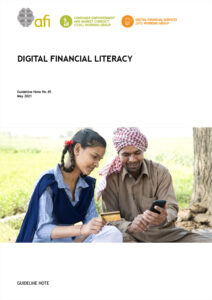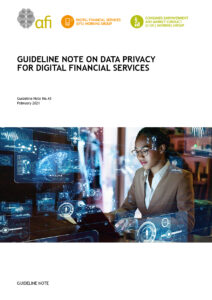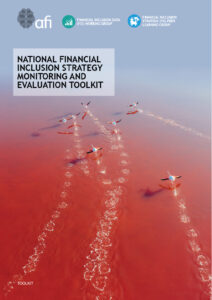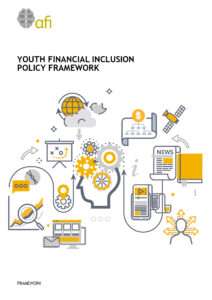Welcome back readers!
From innovative green solutions to groundbreaking achievements in youth financial inclusion, we have spent the last year taking you on an incredible journey that has celebrated how AFI members are harnessing the power of financial inclusion to better the lives of the most vulnerable. Thank you for sharing these remarkable achievements and experiences! Together, we are enriching the knowledge and skills of our network towards reaching our united vision of making financial services more accessible to the world’s unbanked.
We would not want you to miss any of this great work, so have put together a list of our favorite and most impactful pieces for you to enjoy. Without further ado, please enjoy the best of 2021.
Our top five knowledge products
1. Guideline Note on Digital Financial Literacy
 |
Consumers today must keep up with increasingly sophisticated and complex digital banking products and services. Staving off a digital divide by investing in digital financial literacy is paramount to ensuring that no one is left behind. Read more. |
2. Guideline Note on Data Privacy for Digital Financial Services
 |
Digital financial services are transforming markets and lives at lightning speed. But with these changes come new challenges to consumer protection privacy. Read more. |
3. A Policy Framework for Women-led MSME Access to Finance
 |
Women-led MSMEs are crucial for economic growth and job creation. To help them reach their full market potential, AFI created six pillars that regulators can use to support growth in the sector through better access to credit. Read more. |
4. National Financial Inclusion Strategy Monitoring and Evaluation Toolkit
 |
How do we know if a national financial inclusion strategy is working? By implementing a monitoring and evaluation framework, regulators can track progress, achieve targets and shape a financial system built around the needs of the population, particularly the unbanked and financially excluded. Read more. |
5. Youth Financial Inclusion Policy Framework
 |
It is often said that youth are a country’s greatest asset. Regulators can lay a foundation that supports this crucial demographic and fosters future economic growth by removing barriers and promoting youth financial inclusion. Read more. |
Our top five blogs
1.Sustainable solutions way forward for Bangko Sentral ng Pilipinas (BSP)
Recognizing the Philippines’ extreme vulnerability to climate change, BSP Governor Benjamin E. Diokno shares how the central bank is championing sustainability in the financial system through environmentally responsible and sustainable solutions. Read more.
2. Bringing the informal sector onboard
With over two billion people working in the informal economy globally, how best to unlock their potential is one of the greatest challenges facing regulators today. AFI’s vast network may hold the answer. Read more.
3. Financial literacy transforms refugee livelihoods
Refugees often have limited or no access to banks and other formal financial services. Learn from Bank of Uganda on how we can empower this vulnerable group, so that they move forward and live with dignity. Read more.
4. Women must be at the heart of public policy design
Ahead of International Women’s Day 2021, Superintendent Socorro Heysen Zegarra at Peru’s Superintendencia de Banca, Seguros y AFP spoke about how women’s financial inclusion is a key enabler in reducing poverty and improving well-being. Read more.
5. COVID-19 brings opportunities for innovation in women’s financial inclusion
Lesotho is one of the few countries in the world with a negative financial inclusion gender gap with more women having bank accounts than men. Governor Retšelisitsoe A. Matlanyane (PhD) from the Central Bank of Lesotho attributes this to consistent efforts to remove legislation that limits women, not just in the financial sector. Read more.

 About
About
 Online
Online
 Data
Data























